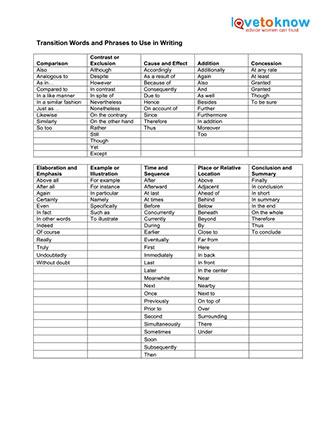
Transition words serve an important function in your writing, making it easy for the reader's attention to move with you from topic to topic. Increasing your vocabulary of these words can help you be more articulate and give you greater flexibility as you write anything from persuasive essays to short stories or novels.
Different Types of Transition Words
Transitions are points in your writing where you move from one topic or setting to another. Because transitions can take many forms, it helps to classify these words according to their use. It's useful to print out this list of transition words and keep it handy as you write.
If you need help downloading the printable list, check out these helpful tips.
Comparison
Use these transitions to show the similarities between two subjects in your writing:
- Also
- Analogous to
- As in
- Compared to
- In a like manner
- In a similar fashion
- Just as
- Likewise
- Similarly
- So too
Contrast or Exclusion
These transition words can illustrate how two subjects differ from one another:
- Although
- Despite
- However
- In contrast
- In spite of
- Nevertheless
- Nonetheless
- On the contrary
- On the other hand
- Rather
- Still
- Though
- Yet
- Except
Cause and Effect
The following words help your reader understand that you're drawing a causal relationship between two subjects:
- Accordingly
- As a result of
- Because of
- Consequently
- Due to
- Hence
- On account of
- Since
- Therefore
- Thus
Addition
These transition words indicate that one subject builds upon another subject:
- Additionally
- Again
- Also
- And
- As well
- Besides
- Further
- Furthermore
- In addition
- Moreover
- Too
Concession
The following words tell your reader that you are making an allowance for an exception or situation that differs from your previous or subsequent subject:
- At any rate
- At least
- Granted
- Granted
- Though
- To be sure
Elaboration and Emphasis
These words help your reader see that you're expanding on or reinforcing a point:
- Above all
- After all
- Again
- Certainly
- Even
- In fact
- In other words
- Indeed
- Of course
- Really
- Truly
- Undoubtedly
- Without doubt
Example or Illustration
Use these words to show that you're giving a specific example of a situation you are presenting to the reader:
- For example
- For instance
- In particular
- Namely
- Specifically
- Such as
- To illustrate
Time and Sequence
The following transition words can help your reader understand that you are changing time or indicating a series:
- After
- Afterward
- At last
- At times
- Before
- Concurrently
- Currently
- During
- Earlier
- Eventually
- First
- Immediately
- Last
- Later
- Meanwhile
- Next
- Once
- Previously
- Prior to
- Second
- Simultaneously
- Sometimes
- Soon
- Subsequently
- Then
Place or Relative Location
These words tell your reader that you're changing location or where one subject is located in relation to another:
- Above
- Adjacent
- Ahead of
- Behind
- Below
- Beneath
- Beyond
- By
- Close to
- Far from
- Here
- In back
- In front
- In the center
- Near
- Nearby
- Next to
- On top of
- Over
- Surrounding
- There
- Under
Conclusion and Summary
Use these words to signal the reader that you're ending a scene or piece of writing:
- Finally
- In conclusion
- In short
- In summary
- In the end
- On the whole
- Therefore
- Thus
- To conclude
Sending Signals to Your Reader
Transitions do more than keep your writing from sounding choppy and unprofessional; they send important signals to your reader. Using these words can help you keep your reader's attention and ensure that he or she fully understands your work. Ultimately, these words help you fulfill your job as a writer.







